Should Your Startup Develop AI Solutions In-House or Partner with AI Experts?

The outcome of any business initiative often depends on the strength and collaboration of its technical team. Factors such as project scope, objectives, features, and budget will shape which AI development model is most suitable.
With AI's rapid evolution, more organizations are poised to integrate this technology into their strategies. Yet, it's essential to recognize that investing in artificial intelligence is not about quick wins; it represents a long-term commitment to expertise. That's why securing the right guidance is crucial for companies aiming to unlock AI's true value.
But how should businesses kick off successful AI projects? Should you build in-house capabilities, or is it smarter to leverage the specialized skills of an external IT partner? Weighing these options carefully will set the stage for faster and more sustainable growth for your company.
In-House AI Development
Building an in-house team of AI developers can seem like an attractive strategy for many organizations. After all, artificial intelligence is poised to become a staple across nearly every business function in the years ahead. Investing in internal experts allows them to develop greater expertise over time. The expense of maintaining such a team could be balanced out compared to the ongoing costs of engaging third-party vendors.
It's also easy to imagine that internal teams will deliver highly customized AI solutions, finely tuned to a company's particular needs. Off-the-shelf AI tools, by contrast, often have limited customization capabilities. And while bespoke solutions built by external specialists are technically an option, they remain financially out of reach for most organizations.
But do these perceived benefits truly stand up to closer scrutiny?
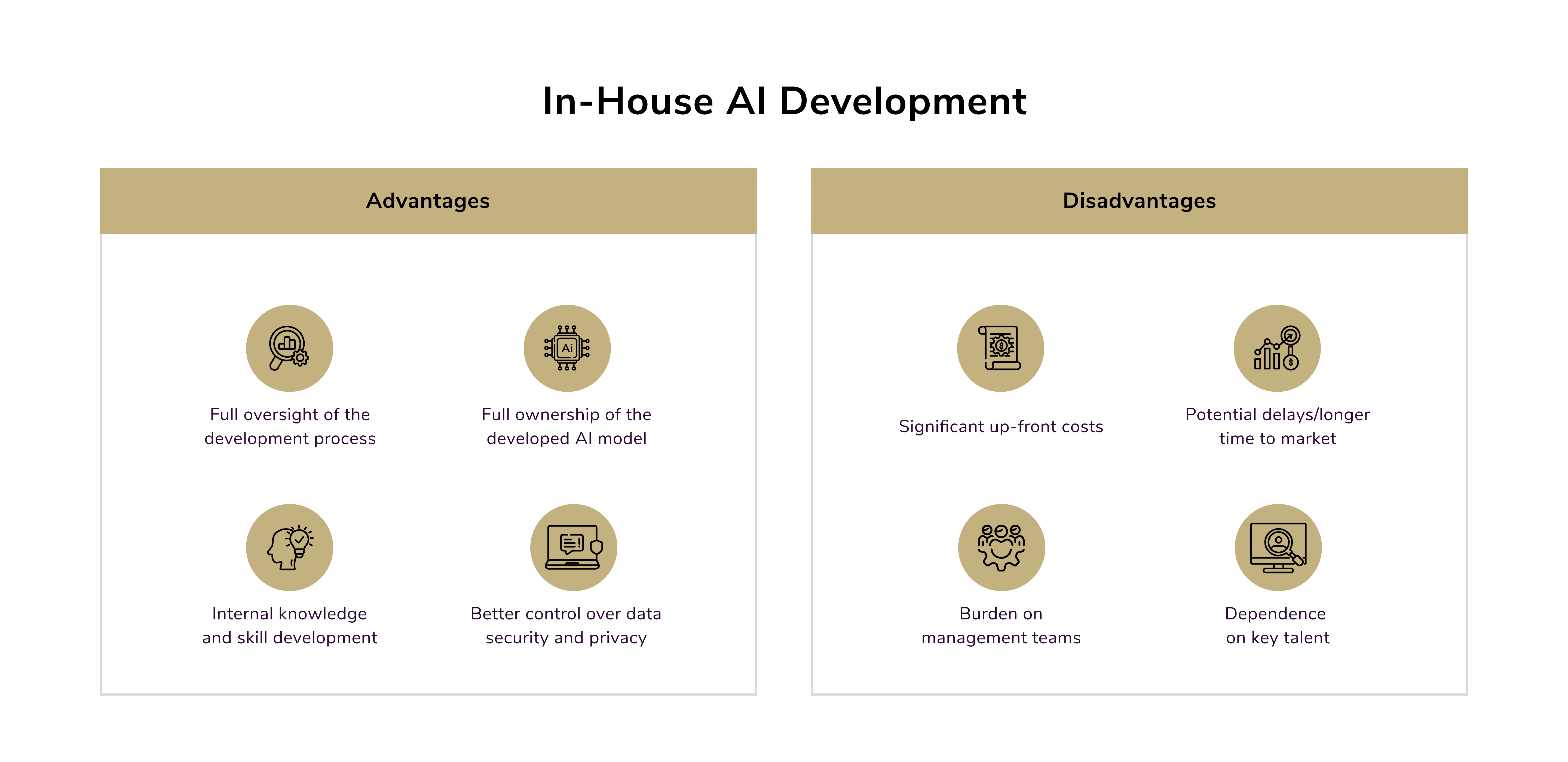
On examination, the two main arguments in favor of in-house AI development prove less decisive than they first appear. See, maintaining a dedicated IT department often puts significant pressure on a company's finances.
Building a Thriving In-House AI Team
Creating a custom in-house AI team goes beyond adopting advanced technology; it's fundamentally about supporting the people who drive innovation. This process calls for careful attention to the different professionals who form the backbone of AI success.
Consider data scientists. They need uninterrupted access to state-of-the-art analytical tools and continuous learning pathways. Why? Their expertise keeps your project future-ready and your organization at the forefront of AI advancement. If you want your team to innovate, aren't ongoing skill investments essential?
Then there are data engineers, the architects of your data infrastructure. Equipping them with modern technologies is an acknowledgment of the foundational role they play in enabling and scaling your AI initiatives. Providing room for their professional growth underscores just how crucial their contributions are to sustained progress.
What about AI product managers? They are vital in translating AI strategy into real-world impact. Including them in high-level discussions and offering avenues for development helps nurture their unique blend of strategic and technical expertise. And no AI vision can succeed without leaders who bridge ambition and execution.
Key Factors Shaping the Cost of Building AI Models Internally
When developing AI models in-house, several critical areas drive up costs. Payroll, research and development efforts, project management, and ongoing system maintenance all play major roles in the total investment.
Building and Keeping the Right Team
To launch an effective AI project, you need a specialized team:
- data scientists
- data engineers
- AI/ML engineers
- project managers
- industry experts, etc.
With intense demand and a shortage of qualified professionals, it's becoming harder than ever to fill these critical roles. Nearly four out of five tech leaders cite a lack of sufficient AI skills as their biggest barrier to deploying AI. Over a quarter even expect the problem to get worse next year.
Scarcity of talent directly impacts wages worldwide. The competition among employers is fierce, as evidenced by ongoing bidding wars between major players like Tesla and OpenAI, with each raising base pay and issuing hefty retention bonuses to keep key talent.
Given these pressures, it's no wonder that employee compensation makes up a large share of development expenses. For cutting-edge AI models such as GPT-4, OPT-175B, and Gemini Ultra 1.0, salaries alone accounted for 29% to 49% of the entire project budget, according to research from Epoch AI.
Investing in Research and Development
AI model development is complex and fraught with challenges. Teams routinely abandon over 80 percent of their candidate models before they are ready for deployment. Why? Most often, poor performance on real-world data, technical failures, or integration problems with older systems make these models unsuitable.
Project managers who lack deep AI experience may not anticipate these hurdles, which leads to surprise cost overruns. And releasing a model to production isn't the end of the road. Companies also have to
- maintain cloud infrastructure
- ensure scalability
- monitore security
- handle ongoing optimization.
Note: A persistent issue in AL model development is "model drift"—the gradual decline in performance as either the input data changes or the business context shifts. If not spotted early, drift can have costly consequences. Take Zillow, for instance, which lost more than $500 million due to an error in its property valuation algorithm that relied on outdated data.
Monitoring and Maintenance
Constant vigilance is crucial. You'll need to establish an observability framework to track important metrics and quickly flag issues like bias or errors, which can carry significant real-world risks. For example, iTutor Group faced a lawsuit after its AI-powered recruitment software unfairly rejected certain job applicants.
Adding to this, emerging regulations demand greater transparency in AI systems. Investing in robust monitoring tools and clearly defined processes supports compliance, minimizes risks, and drives continuous improvement in deployed models. Infrastructure spending is another significant budget item. Costs include not just servers and cloud services, but also APIs, licensing fees, networking, load balancing, integration platforms, and more. If left unchecked, these expenses can spiral.
Outsourcing AI Development
Recruiting IT specialists can be a challenge, but finding AI engineers raises the bar even higher. The process is lengthy and expensive, and can stall essential progress as companies strive to establish internal AI teams.
But what happens once you finally onboard a handful of AI engineers? The landscape of AI is so vast that technical expertise alone isn't enough.
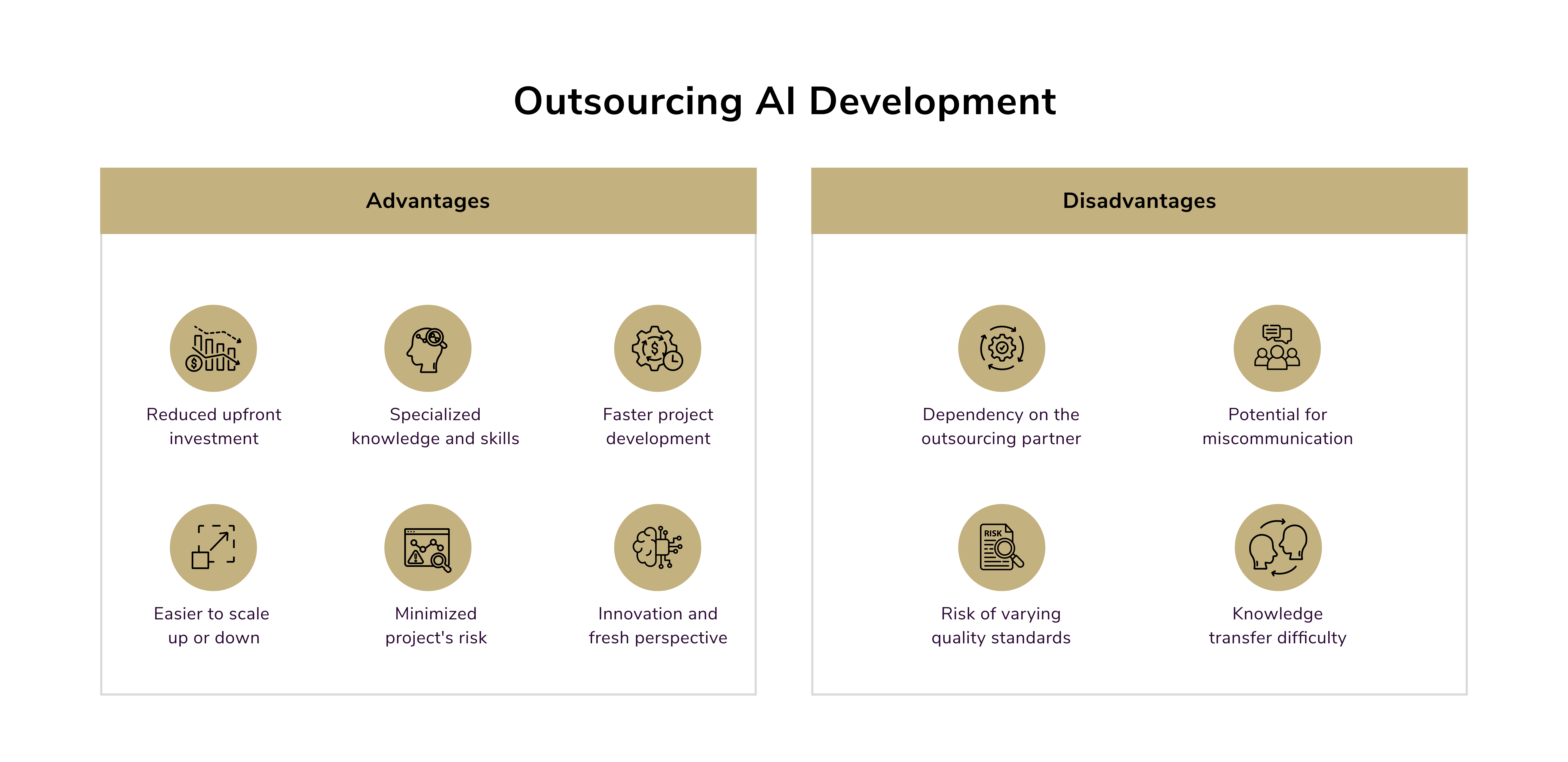
To truly unlock value, your developers need deep domain knowledge relevant to each specific task. The more varied your AI use cases, the harder it becomes for an internal team to cover all the necessary domains.
This is where specialized AI providers set themselves apart. By focusing on particular industries or applications, they can hit the ground running without the steep learning curve that faces many internal teams. Impressit, for instance, set in place a comprehensive framework for accelerated product development to help companies build and launch their solutions faster.
Note: Some argue that outsourcing AI development costs more than building in-house. But seasoned experts can deliver quality results faster because of their deep experience, saving both time and resources. For specialized projects, businesses gain access to top-tier knowledge they might never afford to employ full-time. Plus, there are already robust tools on the market that providers can tailor for unique company needs.
Key Factors Influencing the Cost of Outsourcing AI Development
JoinGenius estimates the IT outsourcing market was valued at nearly $617.7 billion in 2024 and could climb to $806.5 billion by 2029, driven by a compound annual growth rate (CAGR) of 5.48%.
What's fueling this surge? Many industries are eager to cut expenses related to non-core activities while sharpening their focus on what they do best. There are several elements that play a significant role in shaping the overall expense when outsourcing AI development.
Vendor Service Models
With numerous companies offering machine learning and AI outsourcing today, thoughtful vendor selection can greatly affect your project's budget. How do you pick the right partner? Start with essential checks on their reputation, technical prowess, team expertise, security standards, and software development methodology. Pay close attention to which service models they offer, as these directly impact cost and delivery.
Most AI/ML providers work with one or more of these models:
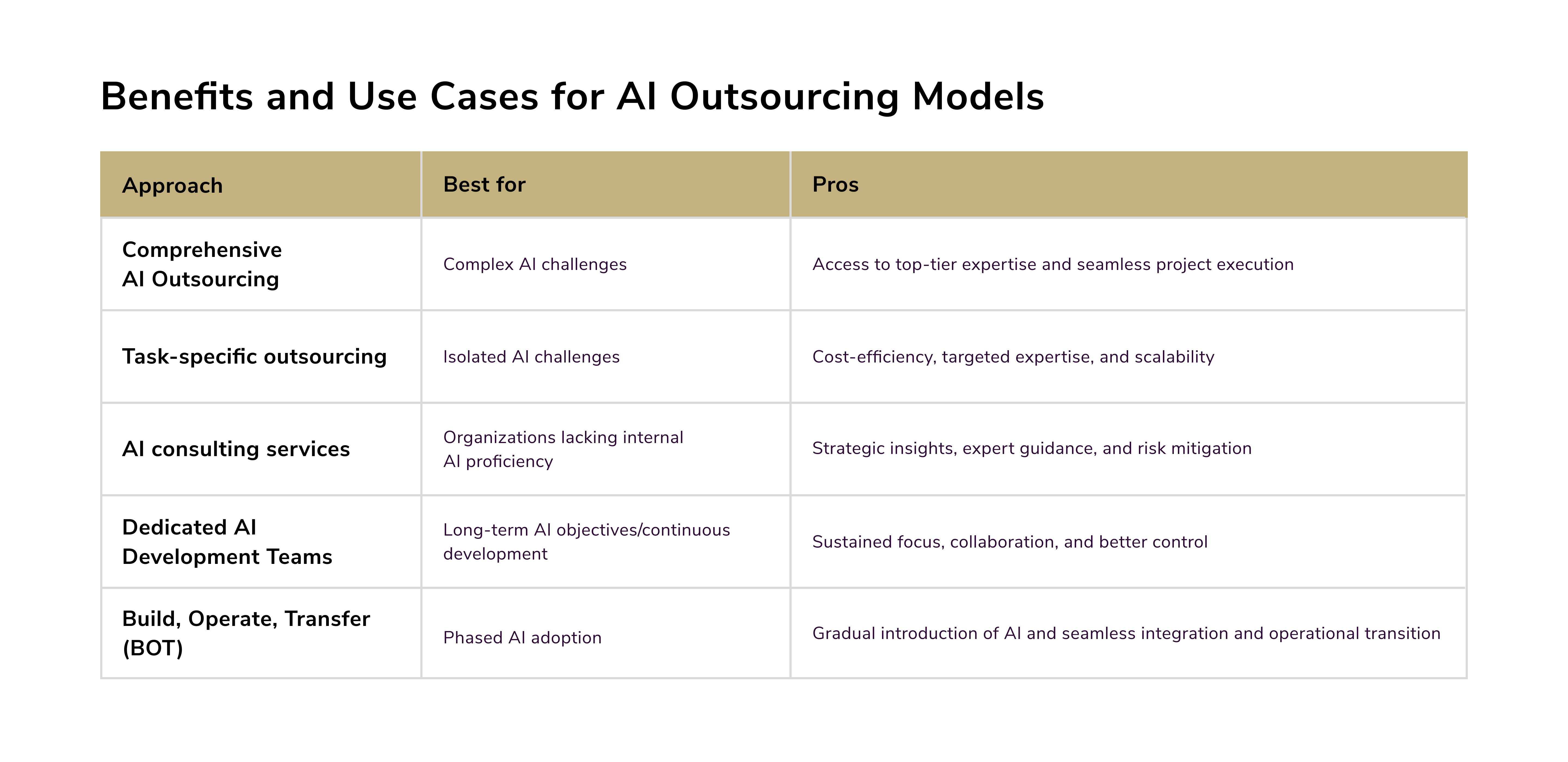
Compared to assembling a full in-house team, outsourcing provides substantial savings on staffing and recruitment. But the true value goes beyond just reducing costs. You gain access to advanced skills, proven deployment experience, and operational flexibility. Many service models make it easy to ramp teams up or down as your needs evolve, letting you react quickly to new business opportunities.
Note: Internal teams require weeks or months of ramp-up to match the expertise of niche service providers, incurring not only salary costs but also outlays for training, hardware, and software. Post-launch, ongoing maintenance demands even more investment. Outsourcing AI development solves many of these headaches. Providers deliver functional solutions rapidly and handle continuous improvements as part of their service.
Project Scope and Complexity
Your project details will largely establish total costs. What should you consider when scoping an outsourced AI project?
- Model complexity. Simple models (such as basic binary classifiers) are less resource-intensive to build than sophisticated systems like reinforcement learning agents or custom large language models.
- Model type. Creating a fully custom solution tailored to your business generally requires a larger initial investment, but can be more affordable over time thanks to lower ongoing maintenance. Pre-configured AI-as-a-Service (AIaaS) solutions offer faster setups, but might limit scalability and customization, sometimes leading to higher total costs.
- Infrastructure needs. Factor in the costs of computing resources, storage, networking, system monitoring, and any integration with your existing infrastructure. If legacy systems aren’t optimized for AI deployment, fixing bottlenecks may raise costs.
- Data requirements. Data quality and quantity are crucial cost drivers. Often, a smaller, high-quality dataset delivers better efficiency than an unwieldy, poorly curated one. Sometimes, adapting your current data pipelines or storage systems is necessary for optimal model training.
Most successful AI projects start small. A proof of concept (PoC) lets you validate the model approach and iron out kinks before investing further. From there, a well-structured product roadmap details enhancements and scaling steps. This iterative approach reduces the risk of gambling resources on untested ideas and helps preserve cash flow.
Communication and Collaboration
Communication may be the hidden x-factor for budget control. Poorly defined requirements, project delays, costly revisions, and a tendency to focus on technology rather than business value are all avoidable with better communication. Unrealistic expectations or failing to acknowledge current AI limitations can also fuel project issues.
An ideal AI expert partner should flag holes in your strategy and propose better alternatives. For this process to work, your organization must also be open to feedback and ready to iterate. Building this kind of trust takes time, but it is critical for shared accountability.
Machine Learning Development In-House vs Outsourcing
Machine learning development entails designing, training, and deploying AI models with the goal of automating tasks, enhancing decisions, and extracting actionable insights from vast data pools. Industries ranging from healthcare and finance to retail and logistics are leveraging machine learning to gain a competitive advantage. Whether it's optimizing internal workflows, forecasting consumer trends, or bolstering security, the applications are vast and growing.
The heart of ML development centers on three elements:
- Data preparation and model training to hone AI efficiency and accuracy.
- Algorithm selection and validation to ensure reliable results.
- Integration of AI with existing business systems for real-time automation and analytics.
Forming an internal AI team for ML model development gives you direct oversight over processes. But this control doesn't come cheap or easy.
The obvious upsides of internal development include:
- Highly tailored solutions that address specific business needs.
- Long-term investment in domain knowledge and proprietary expertise.
- Complete supervision over data security and compliance, critical in regulated industries.
The downsides of this approach are as follows:
- Intense competition for AI talent, particularly in cutting-edge domains like natural language processing.
- Substantial ongoing investment in salaries, infrastructure, and technology upgrades.
- Longer lead times, as assembling a capable AI team and developing new models can be a slow process.
Note: When speed, flexibility, and efficiency take precedence, outsourcing becomes an attractive solution. Many organizations looking to accelerate deployment and manage costs turn to external machine learning experts. For companies determined to keep costs predictable and timelines short, staff augmentation offers a clear on-demand edge. Rather than spending months building a team, organizations can work with consultants who are ready to deliver results immediately.
Comparing Costs
The debate often comes down to cost. While AI is often essential for innovation and competitiveness, the return on investment depends heavily on your chosen approach. Building an in-house team involves fixed expenses such as employee compensation, cloud infrastructure, software licenses, training, and maintenance. Conversely, outsourcing typically offers flexible, project-based costs that can be scaled according to business needs.
Large enterprises might justify the investment for full control and strategic longevity. However, for many, outsourcing ML is a practical way to gain expertise and innovate quickly, all while maintaining control over budgets and outcomes.
Finding the Right Outsourcing Partner for AI Projects
Selecting the most suitable partner can be a game-changer for your project's success. Here's how to approach your search and management strategy with clarity and confidence.
Start with Thorough Research
First, how do you identify companies with genuine expertise in AI? Examine their core areas, review case studies from previous projects, and see who their clients have been. Do customer testimonials suggest a strong track record? Before committing, schedule a consultation to discuss your vision. This is your chance to gauge the company's approach, assess how its strategies align with your needs, and get a sense of any potential risks involved.
Don't hesitate to ask for references and a comprehensive portfolio. A credible outsourcing company will have a showcase of its past work. Focus especially on projects that intersect with your own industry to see how relevant their expertise is.
Evaluate Technical Capabilities
AI is a specialized field that demands a high level of knowledge and technical skill. Does the firm demonstrate experience working with machine learning, big data, and business intelligence? Building robust AI products requires a multidisciplinary team. It's crucial to choose a software development partner that possesses the proficiency and resources required for such complex projects.
Key Questions Before Making Your Selection
Outsourcing to regions with lower labor costs can offer significant financial savings. But the decision shouldn't be based on cost alone. Have you asked yourself these important questions?
- Can you communicate clearly with the team? Fluent English is vital for preventing misunderstandings.
- Are you in compatible time zones? For smooth collaboration, time differences ideally shouldn't exceed eight hours.
- Is their billing and accounting set up to meet your local regulatory standards? Your partner should be able to align with your accounting requirements.
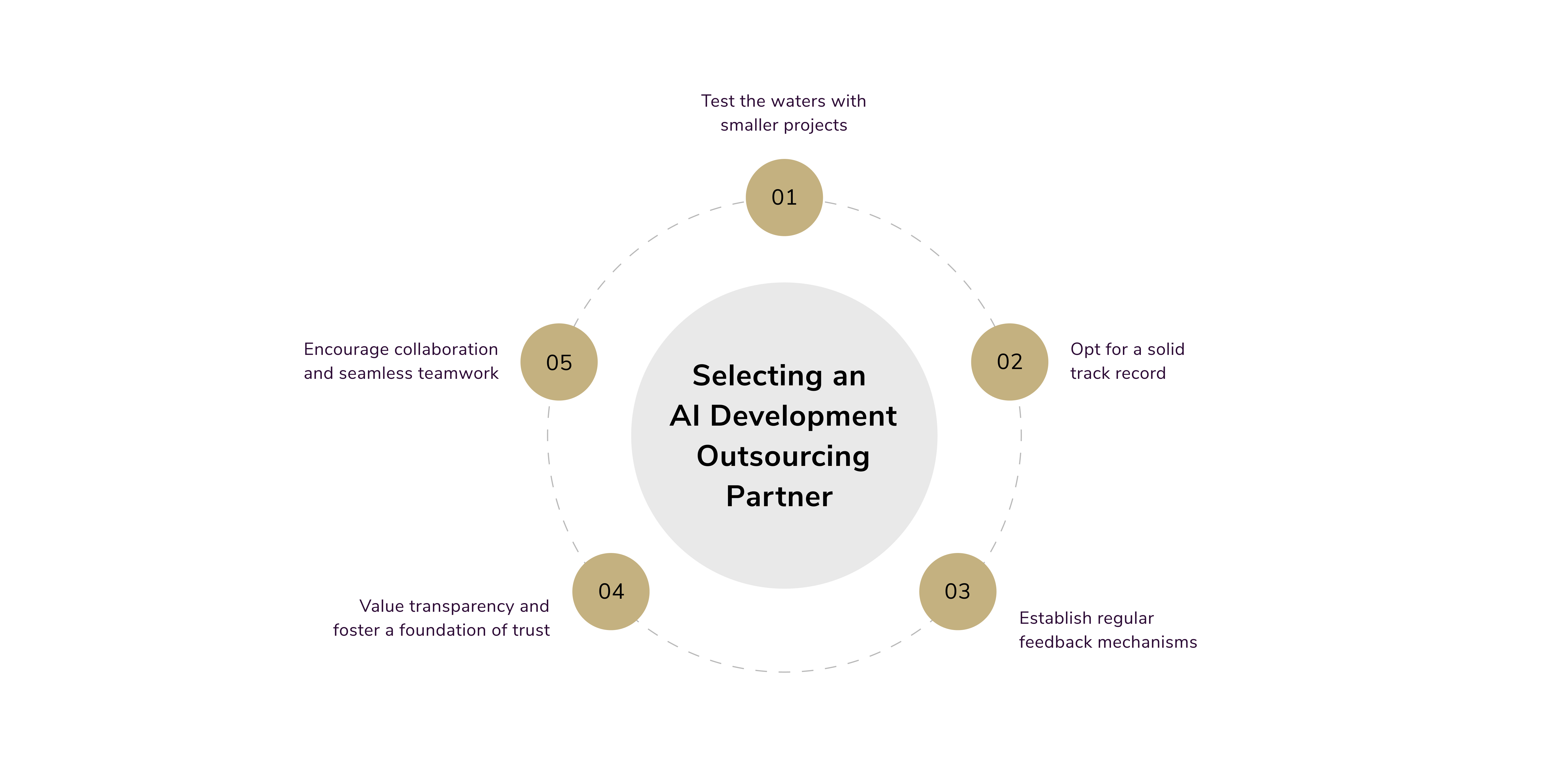
Best Practices for Managing Outsourced AI Initiatives
When your project is underway, how do you ensure smooth cooperation and timely delivery? Here are some proven strategies:
Set Clear Objectives
Begin with well-defined goals and a project scope that follows the SMART framework (Specific, Measurable, Achievable, Relevant, Time-bound). Detailed briefs help both your internal and outsourced teams stay aligned and minimize the risk of misunderstandings or project drift.
Maintain Open Communication
Leverage multiple channels like video calls, instant messaging, and project management tools to facilitate ongoing collaboration. Regular check-ins and status updates create a transparent environment where issues can be addressed early.
Promote a Culture of Transparency
Foster an atmosphere where team members are encouraged to discuss challenges and ideas. Openness helps flag risks before they escalate, building trust across teams.
Monitor Performance
Establish clear KPIs to track progress and quality. Routine assessments against these indicators ensure the project stays on track. Encourage feedback throughout the process to keep improving and ensure all team members feel invested in outcomes.
Cultivate Collaboration
Strong relationships with outsourced partners lead to better results. Regular face-to-face video meetings and, where possible, on-site visits reinforce team unity. Treat external teams as true extensions of your business to foster engagement and shared accountability.
Leverage the Right Technology
Managing complexity requires robust tools. Project management platforms like Jira, Trello, or Asana help you assign tasks, visualize progress, and facilitate collaboration. Adopting Agile or Scrum methodologies can also be beneficial, allowing you to adjust quickly as requirements evolve.
Monitor and Adapt Continuously
Keep a close eye on milestones with real-time dashboards. Stay flexible and be ready to redefine objectives as your business environment or project demands change.
Weighing the Strategic Effect on Your Business
Building AI solutions in-house puts you in the driver's seat, allowing for customized results and hands-on management. Yet, outsourcing to specialists like Impressit can help you leapfrog the competition. Why? Because it gives you immediate access to niche expertise, turbocharging your innovation and sharpening your edge in the market.
Comparing Costs and Forecasting ROI
The financial landscape looks different depending on whether you manage custom AI projects internally or partner with an external provider. To make the right call, analyze the full cost of ownership, likely returns, and the downstream value of the AI initiatives you pursue. Outsourcing is often appealing here, offering flexibility and minimizing large upfront costs that can slow progress.
Flexibility and Scaling as Your Needs Evolve
How adaptable is your strategy as your company grows? The scalability of your chosen approach is crucial. Outsourcing stands out for its agility; it lets you increase or decrease your AI development efforts as business demands shift, without running up against the limitations of in-house resources.
Maintaining Alignment with Company Values and Culture
Ensure your chosen development path fits seamlessly with your organization's vision and ethos. A strong partnership with an AI development firm should encourage smooth collaboration and reflect your company's core values while supporting your strategic direction.
Why AI Product Development Strategies Shift
Sourcing and retaining AI talent has become increasingly difficult and costly. The average annual salary for a skilled AI engineer is hovering around $175,000. When you factor in the expenses for recruiting, benefits, and employee retention, it's easy to see why businesses are reconsidering their approach to AI development. More organizations are tapping into outsourced AI teams to bridge skill gaps quickly, sidestepping lengthy hiring hurdles.
In addition, the race to market has never been more intense. Move too slowly, and you risk falling behind. According to McKinsey, companies deploying generative AI are already seeing 3% to 15% revenue boosts and a rise in sales ROI of 10% to 20%. Outsourced AI specialists are enabling businesses to accelerate development by 60% to 70% compared to newly established in-house teams. It's no wonder many decision-makers are revisiting their development playbooks.
Navigating Increasing AI Complexity
The days of simply building new AI models are long gone. Modern AI projects in 2025 should strive to
- address data privacy regulations
- mitigate algorithmic bias
- ensure transparency
- safeguard against cyber threats.
These demands drive the search for rare, highly specialized talent, which is often more accessible through outsourcing than internal hiring.
Building internal AI departments involves a long list of indirect costs, from cloud services and licensing fees to ongoing training and salaries. Outsourcing removes much of this financial strain by offering flexible, pay-as-you-go arrangements, bringing greater transparency and predictability to budgets. Besides, the shelf life of AI solutions continues to shrink, with new advancements rolling out every few months. Companies must rapidly test new ideas and develop minimum viable products (MVPs) to stay competitive.
Summing up
Keep in mind that outsourcing AI development isn't a magic bullet. However, for many organizations, its advantages can far outweigh the drawbacks compared to building everything in-house. Naturally, every approach comes with a set of trade-offs. But when resources, expertise, or strategic clarity are limited, collaborating with external providers often offers more flexibility and lower risk.
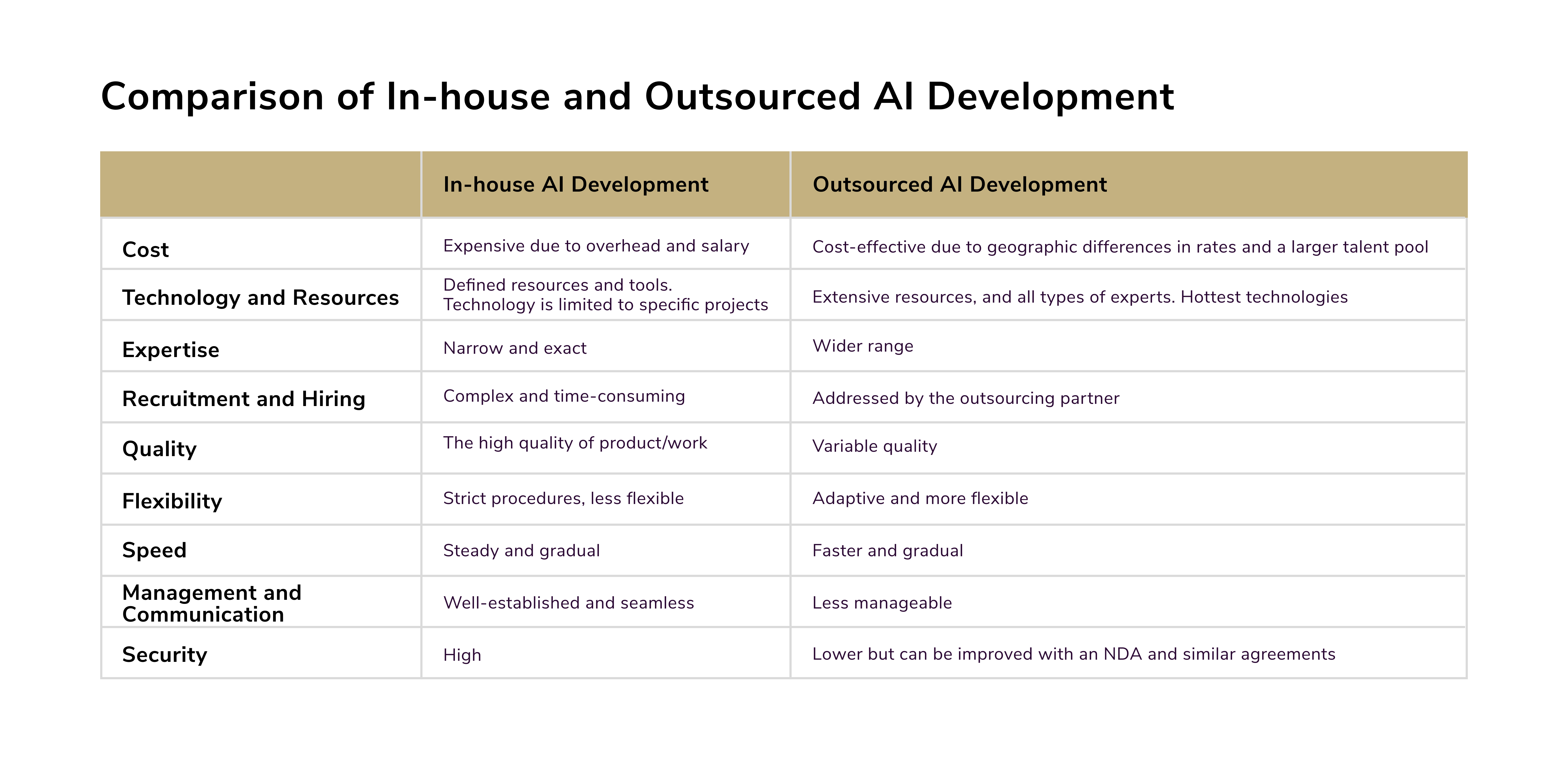
However, choosing the right AI partner demands careful work upfront. The more thorough your vetting process, the smoother your future collaboration will be. Key questions to consider include:
- Has the provider demonstrated success with similar projects in your field?
- What kind of industry experience can they show?
- Is their reputation backed by strong references and case studies?
- Do they deliver reliable support and customer service?
- How do they address your company's privacy and confidentiality requirements?

Roman Zomko
Other articles